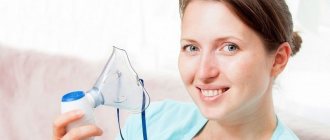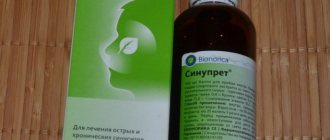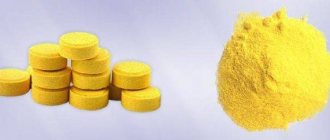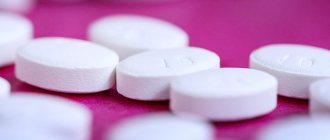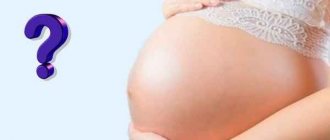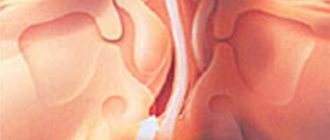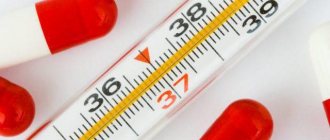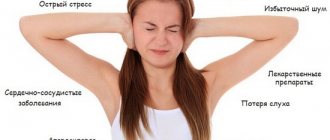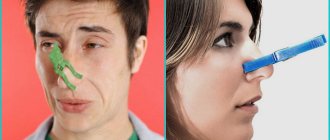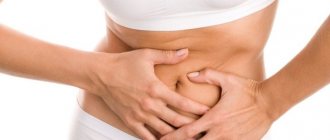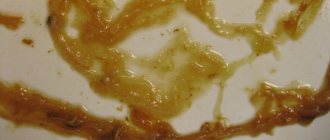Inhalation has always been considered an effective method in the fight against colds in adults and children. Both dry and wet coughs can be treated in this way. Thanks to such therapeutic measures, it is possible to eliminate the pathological process, reduce the period of the disease, and sometimes completely cure a person from the disease.
Medicine has long proven that inhalation is a safe method of treating cough in children. This therapy is considered an excellent alternative to medications. With the help of inhalation, medicinal substances enter through vapors into all parts of the respiratory system and eliminate coughing attacks. This method has been popular for decades and does not have any side effects on humans. It will not be difficult for a child to perform this procedure.
What types of nebulizers exist:
- Ultrasonic nebulizer. Typically produced in compact sizes and characterized by silent operation. This inhaler is ideal for children under one year old.
- Compression nebulizer. It comes in large sizes and is noisy, but despite these disadvantages, it is capable of producing small particles that penetrate the lungs and nose. This device is suitable for children over 1 year old.
Before purchasing a nebulizer, you should take into account the child’s age and the form of the disease. With the right choice of inhaler, you can quickly cure your baby’s cough without negative consequences.
Indications for inhalation with saline solution
Saline solution can be used quite widely to combat cough. Indications for the use of this drug in the form of inhalation are:
- cough caused by infectious lesions of the mucous membrane;
- allergic cough;
- bronchial asthma;
- pneumonia in the final phase;
- pulmonary tuberculosis;
- fungal infections of the lungs;
- inflammation of the mucous membrane caused by severe dry air.
At the discretion of the doctor, additional medications may be added to the saline solution, the choice of which depends on the patient’s condition and the degree of the disease. Saline solution can be combined with various expectorants, anti-inflammatory and even antibiotic drugs.
Disinfection of mouthpieces for inhalation
Pathogenic microorganisms remain on the walls of the nozzle, which need to be eliminated. Disinfection is carried out using any antiseptic. Most often used:
- medical alcohol;
- hydrogen peroxide;
- soda solution;
- laundry soap.
Upon completion of the procedure, you should wipe the inhaler nozzle with an antiseptic and rinse with plenty of water. When the course of treatment is completed, you need to boil the mouthpiece for several minutes to finally eliminate the pathogenic microorganisms.
Be sure to disinfect the nozzle when using the nebulizer by several patients, including relatives. Before placing the device for long-term storage, you need to thoroughly boil the removable parts of the inhaler, dry them naturally, and put them in a plastic bag.
Read more in the article: Disinfection of the inhaler.
What effect does saline have on the mucous membranes of the respiratory system?
In order to understand why coughs can so often be cured with saline inhalations alone, you need to understand how this solution affects the body.
Getting on the mucous membranes in the form of an aerosol or with steam particles, the drug produces a pronounced softening effect. It allows you to relieve the feeling of tickling and rawness that often occurs when coughing, not only in the throat, but also behind the sternum.
In addition, sodium chloride promotes intensive hydration of the mucous membrane and thins sputum. Even very viscous mucus under the influence of the drug softens, becomes more plastic, noticeably easier to separate from the mucous membrane and removed from the bronchi and lungs. The expectorant properties of the medicine allow you to clear the respiratory system of excess mucus in the shortest possible time.
Inhalation for cough with nebulizer recipes for children
Now let's look at how to use inhalations when a child has a cough. A nebulizer can be used at home; it helps to quickly get rid of a strong and painful cough. This device belongs to compressor inhalers, therefore it has a number of advantages.
- The device helps to develop solution particles into dust. The breaking process occurs using ultrasound.
- For infants, as well as older children, the nebulizer helps deliver the active substance precisely to the inflammatory focus itself.
Let's consider what can be used for inhalation? There are many recipes for inhalation with a cough nebulizer for children, but the most important thing is to choose the right solution or medicine. After all, the selection of solution depends on the type of cough.
Saline solution helps clear the bronchi when coughing. If a child has a hoarse or “barking” cough, for example, as with laryngitis, then in this case, use folk decoctions at home.
Traditional medicine has long shown its healing properties. Calendula-based tincture helps with coughs. How to properly prepare a solution for inhalation? First, the calendula is boiled, after which the finished broth is strained through sterile gauze using a colander. Then all that remains is to pour the broth into the apparatus and carry out the procedure.
Children should use medications and decoctions at an early age only after prior consultation with a doctor.
You can also use:
- Mineral water, it helps normalize breathing.
- At an older age, you can prepare alcohol tinctures based on propolis. Such inhalations have an antiseptic as well as a softening spectrum of action.
- Recipes based on horsetail, dandelion or oak bark are effective.
The most important thing to remember is that you need to prepare the folk recipe correctly, otherwise, not only will there be no effect, but complications will also arise.
General rules for inhalation
If you do not know and do not follow the general rules for inhalation, it is difficult to count on a good result. When carrying out treatment using this procedure, you must adhere to the following recommendations:
- Inhalation can be carried out no earlier than 2 hours after eating;
- it is unacceptable to exceed the dosage of the medicine;
- it is unacceptable to arbitrarily increase the duration of the procedure;
- inhalations are carried out through the mouth, and exhalations through the nose;
- all parts of the nebulizer that are in direct contact with the patient (mask, breathing tube) must be treated with an antiseptic after each use;
- exit from the room to the open air after inhalation is possible no earlier than 1.5 hours;
- inhalations with the addition of medications should be carried out only on medical advice.
Video recipe for the occasion
:
By adhering to these rules, you can get the maximum benefit from inhalation.
How to breathe through a nebulizer mouthpiece
The mouthpiece for the inhaler is placed on the chamber where the solution is located and it is converted into an aerosol. The second end is inserted into the mouth and tightly wrapped around the lips. Inhalation is very simple.
How to breathe correctly through the mouthpiece of a nebulizer:
- take a slow deep breath;
- hold your breath for 2 seconds;
- exhale through the nose;
- repeat the steps.
An adult needs to breathe through a nebulizer for an average of 10 minutes, children – 5. You need to breathe deeply, but calmly. With frequent breathing, dizziness appears and the cough intensifies.
When treating with antibiotics or hormonal drugs, after completing the procedure, you need to rinse your mouth with clean water or saline solution. Such actions will help avoid the development of side effects such as stomatitis, oral candidiasis, and sore throat.
The mouthpiece should be inserted behind the teeth so that the medicine penetrates into the mouth and lungs. Very often, children and even adults do not inject it deeply enough, which significantly reduces the effectiveness of the procedure.
Features of inhalation with saline solution for adults
In order for cough treatment with saline to produce results, it is important to be able to carry out the procedure correctly, using the correct dosage of the drug. Inhalation can be carried out either using a special device designed for inhalation - a nebulizer, or without using it.
Inhalation of saline solution using a nebulizer
It is best to use a nebulizer for the treatment procedure, which allows the patient to use the medicine as effectively as possible, without overloading his body with exposure to hot steam. It is for this reason that inhalations with a nebulizer can be carried out even at elevated body temperatures.
The procedure requires the drug heated to room temperature, otherwise discomfort may occur during inhalation. For one inhalation, you need to pour 3 ml of saline solution into a container intended for the medicine and carry out a procedure lasting no more than 7 minutes. Inhalation is repeated once every 12 hours. If the duration of inhalation is increased, too much fluid will enter the lungs and bronchi, which will have an extremely negative impact on the patient’s condition and in some cases will even cause an urgent request for medical help.
How to treat dry cough in children with a nebulizer
Most often, tracheitis with a suffocating, frequent cough develops in young children. In the absence of proper treatment, the condition worsens; during attacks, severe bronchospasm occurs, which makes it difficult to breathe. To improve the child’s condition, complex therapy using drugs of different spectrum of action is required.
The main task is to make the cough productive, eliminate attacks, and stop the inflammatory process.
- Baking soda and saline solution will help increase the formation of sputum and facilitate the removal of mucus from the bronchi and lungs. To obtain the medicine, soda is diluted in warm boiled water, mixed, allowed to stand, and poured into the inhaler container without sediment. There is no need to dilute the saline solution with anything. Inhalation duration is 2-3 minutes. The drugs moisturize the mucous membrane, eliminate irritation, and stop dry cough. In addition, the procedures are carried out with antitussives Tussamag and Lidocaine.
- The attack occurs due to muscle spasm. At the same time, the child’s breathing is blocked and it is impossible to breathe in the air deeply. Inhalations with bronchodilators will help to quickly relieve spasms. Most often prescribed are Ventolin, Berotek, Berodual. The products relax muscles, facilitate breathing, and stimulate the removal of mucus.
- Diseases of the upper and lower respiratory tract are accompanied by inflammation. To stop the inflammatory process, antibacterial or hormonal drugs are prescribed. Breathing procedures with antibiotics are prescribed if there are contraindications for oral administration. Hormonal medications stop inflammation, eliminate allergies, relieve swelling, and reduce mucus formation. Pulmicort is most often prescribed. Self-administration of medications without consultation with specialists is not allowed. The disease must be treated in combination with other medications.
You should not use a nebulizer as soon as an alarming symptom appears. It would be more correct to carry out steam procedures using plant decoctions and essential oils. Tablets, syrups, and drops are effective at this stage. A nebulizer for dry cough symptoms is used if other therapeutic measures do not give the desired effect.
Moreover, the ability of the inhaler must be taken into account. A nebulizer converts the medication into an aerosol with particles of different sizes. Small ones enter the lower respiratory tract, large ones settle in the upper respiratory organs. For dry coughs, deep delivery of the medicine is undesirable. Therefore, you need a nebulizer on which you can adjust the frequency of spraying.
Video
Post-procedure care
To prevent early wear of the inhalers after the procedure, it is recommended to rinse the solution container and mask with warm water and dry the device naturally. Do not use a dishwasher to clean the device. The inhaler should be stored in an appropriate box out of the reach of children.
Video about inhalation for dry cough
You just need to know that after inhalation the patient should try to talk less for 30-45 minutes to retain the maximum amount of medicinal substances on the mucous membrane of the upper respiratory tract. An active conversation provokes another irritation of the epithelium with the occurrence of attacks of dry cough.[/blockquote_1]
After the appropriate procedure, you can drink a glass of hot tea with raspberries and lemon, or warm milk. There is an additional decrease in the severity of irritation of the mucous membrane.
Mask or mouthpiece
The nebulizer comes with several accessories:
- mouthpiece;
- cannulas - for administering medicine through the nose;
- mask.
The last attachment is universal. It is used to treat the upper and lower respiratory tract; it is allowed to breathe through the nose and mouth. Available in several variations - for adults, children. It differs in size, sometimes in design. To understand what is best to use, you need to compare the advantages and disadvantages of each accessory.
| Advantages | Flaws | |
| Mask | Can be used by small children up to 1 year old. | A large amount of active substances settles on the walls of the mask, reducing the effectiveness of the procedure. |
| Breathing through the mouth and nose is allowed. | The nozzle does not fit tightly, active components leak, and the device runs idle. | |
| Convenient to use. | ||
| Mouthpiece | The efficiency of inhalation increases. | Uncomfortable to hold in your mouth for a long time. |
| The likelihood of side effects when using antibiotics and hormonal drugs is reduced. |
There must be 2 accessories for the inhaler. It is impossible to say unequivocally which one is better. It all depends on the patient’s age, character, and severity of the disease.
Inhalation with saline solution for a runny nose
Is it possible to spray an isotonic suspension for snot? In most cases, this action is effective in combating runny nose, atrophic rhinitis, and infectious discharge from the nasopharynx.
Why do they spray substances like this into the nose? It improves the discharge of mucus, moisturizes the mucous membrane, removes pathological exudate, and softens dry crusts.
Treatment of a runny nose with saline can be carried out by adding essential oils, sea buckthorn, Kalanchoe, etc. To avoid the development of allergic reactions, it is better not to self-medicate.
To help with treatment: Rinsing the nose with saline: is it possible to rinse the nose with saline?
Creating a nasal aerosol with a nebulizer gives a positive result and does not cause side effects.
